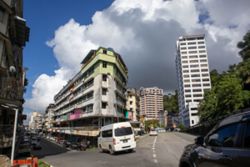
Deputy Premier Datuk Amar Dr Sim Kui Hian (seventh left) unveiling the Chinese couplets in conjunction with the 50th anniversary of Malaysia-China diplomatic relations at the Malaysia-China Friendship Park in Kuching. - ZULAZHAR SHEBLEE/The Star
THIS year marks the 50th anniversary of Malaysia and Singapore’s diplomatic ties, which was established on May 31, 1974, and Malaysia became the first country in Asean to establish diplomatic relations with China.
It also marks the 11th anniversary of the establishment of the China-Malaysia Comprehensive Strategic Partnership, which paved the path to a track of comprehensive, mutual and mature development.
Malaysia’s top leadership has been playing a pivotal role in shaping the evolution of Malaysia-China relations, which has been nurtured and grown over centuries dating back to the era of the Ming Dynasty and the Malacca Sultanate in the 15th Century.
It began with the second Prime Minister Tun Abdul Razak’s exemplary contribution in initiating diplomatic ties with China, laying the path towards a milestone in normalising Malaysia-China bilateral relations.
Throughout the 1980s, 1990s and up to 2003, the fourth Prime Minister Tun Dr Mahathir Mohamad double-downed on the government’s efforts in strengthening relations with China, focusing on economic cooperation and investments.
When the 1997-1998 Asian Financial Crisis hit the region, some commented that Dr Mahathir had appreciated China’s resistance to its yuan’s devaluation pressures and had helped Asian economies to recover. Malaysia had worked together with other Asean countries to develop the relations between Asean and China, with China becoming a full dialogue partner with the regional bloc in 1996.
Malaysia supported China’s accession into the World Trade Organisation (WTO) in 2001. The Asean-China Free Trade Area (ACFTA) agreement was signed on Nov 5, 2003 and subsequently upgraded to ACFTA 2.0 in 2008, and is currently negotiating for ACFTA 3.0 to be concluded by end-2024.
During former Prime Minister Datuk Seri Najib Razak’s (2008-2018) leadership, the Malaysia-China bilateral relations and cooperation was exchanged in-depth, elevated and upgraded to a Comprehensive Strategic Partnership in 2013.
Najib was very supportive of China’s Belt and Road Initiative. Both countries have expanded economic and trade cooperation in areas of industrial and manufacturing, automobile, transportation, information, communications and technology (ICT), education and financial services.
Under Dr Mahathir’s administration 2.0, Malaysia-China’s relations remained cordial and firm amid concerns and uncertainties pertaining to some mega projects with China’s involvement and funding.
Dr Mahathir had visited China and shown interest in China’s remarkable development in the fields of digitalisation, eCommerce, automobile and agriculture.
When the unity government came to power in 2022, Prime Minister Datuk Seri Anwar Ibrahim visited China two times and invited Chinese president Xi Jinping and premier Li Qiang for an official visit to Malaysia in conjunction with the 50th anniversary of Malaysia-China’s diplomatic relations in 2024.
In 2023, there were 12 top exchange visits from Malaysia to China and six highest exchange visits from China to Malaysia. Both countries have touched on various bilateral, regional and international issues of mutual importance.
In 2023, Malaysia secured a total of RM189.84bil worth of investment and memorandum of understandings with China.
This covered commodities and agricultural-based industries (such as oil palm, rubber, biodiesel, durian, food security), automobile (electric vehicles and high technology), cooperation in the field of technical and vocational education and training, cooperation in science and technology and vaccine development technology, warehousing and logistics and waste-to-energy power plants, and so forth.
In the aspect of connectivity, both countries have agreed to step up cooperation in tourism as well as increasing flight frequencies between Malaysia and China.
Malaysia and China have waived travel visa requirements for each other’s citizens starting in November and December last year which is expected to boost the growth of bilateral tourism activities.
This month, Shanghai Airlines and China Eastern Airlines are set to boost flight services between Malaysia and China, with a commitment to a minimum of 62 weekly flights. Malaysia and China’s bilateral trade has grown rapidly over the decades, especially after China’s accession into WTO in 2001.
Between 2001 and 2010, Malaysia’s trade with China had grown by 19.9% per annum to an average of RM90.6bil per year. It grew by 8.9% per annum to average RM239.2bil per year in 2011 to 2019.
Post Covid-19 pandemic, total trade increased by 9.2% per annum to an average of RM435.3bil per year in 2020 to 2023.
Now, China remains the largest trading partner of Malaysia for the 15th consecutive year since 2009, making up a share of 17.1% of Malaysia’s total external trade in 2023 (13% in 2010 and 4.7% in 2001), with exports share of 13.5% in 2023 (12.5% in 2010 and 4.4% in 2001).
Malaysia is the second biggest Asean country trading with China since 2022. Malaysia’s major export items to China continued to be dominated by electronics and electrical products, palm oil, oil and gas, and plastic products, with a value of RM102.3bil (or 58.6% of total exports) in January to November 2023.
Malaysia also benefited from China’s outward foreign direct investment, especially in the manufacturing sector.
In 2005, China was the 13th largest foreign investor in the manufacturing sector and thereafter advanced higher to become the largest foreign investor for five years in a row (2016 to 2020) before being relegated to third place in 2023 (second placing in 2022 and third placing in 2021).
Amongst these include the Malaysia-China Kuantan Industrial Park, the sister park of China-Malaysia Qinzhou Industrial Park, Xiamen University Malaysia, Huawei technologies, Geely’s acquisition of Proton, Malacca Gateway, Kuantan Port’s expansion, Digital Free Trade Zone, Forest City, the Gemas-Johor Baru electrified double-tracking railway project, the East Coast Rail Link and so on and so forth.
China tourist arrivals in Malaysia also increased steadily, from an average of about 615,900 persons per year in 2000 to 2008 to an average of 1.9 million tourists per year in 2009 to 2019, hitting a high of 3.1 million tourist arrivals (11.9% of the total tourist arrivals in Malaysia) and generated foreign exchange earnings of RM15.3bil (17.8% of the total).
Post-Covid, China tourist arrivals had recovered gradually to one million of China’s tourists (7.2% of the total) as of September 2023.
Both countries must commit to forge a new partnership of a win-win cooperation and ensure a sustainable and greener community of shared future for both its citizens, build on past achievements and forge ahead of the future.
Malaysia and China must continue to deepen bilateral economic and diplomatic efforts, foster closer cooperation to benefit from new progress and development in the future.
Malaysia-China relations are currently at a strategically opportune time for development through strategic partnerships.
We should set new goals and priorities so as to push bilateral cooperation to scale new heights. The first step is deepening mutual trust and sustaining the comprehensive strategic partnership for mutual benefit and win-win results.
In this era of profound changes in geopolitical landscapes and the international trade system, Malaysia and China have many common goals, such as promoting and achieving sustainable development, advancing pragmatic cooperation in key sectors such trade, technology, energy, climate change, and coordination in multilateral trade agreements.
The second step should be the commitment to a free trade, free competition and open cooperation. This are the fundamental norms of the market economy.
Continuing to tap into the growth potential of both the countries’ bilateral trade by committing to creating a better policy environment for each other, optimising the trade structure and further unleashing trade flows in ACFTA, and regional comprehensive economic partnership in also key.
China and Malaysia have signed the first protocol to amend the Agreement on Expanding and Deepening Economic and Trade Cooperation, laying the policy foundation for further cooperation.
Third, Malaysia is on the path of economic and industrial transformation and in need of China investments and technology in our industrial structures and exploring new areas of cooperation in the high-technology electronics sector, digital economy, green investment, electric vehicles, renewable energy and emerging energy sector such as hydrogen and e-methane; smart agriculture as well as the healthcare industry.
China has a lot to offer given its advancement in artificial intelligence, digitalisation and automation.
Both countries can strengthen financial cooperation, and to expand the use of local currency in trade and investment, a move to reduce over-dependency on the US dollar.
Fourth, both countries can advance high-quality Belt and Road Initiative cooperation and the Pan-Asia connectivity to safeguard the stability of global value chains and supply chains.
Both sides can upgrade Malaysia-China freight transport facilities for higher capacity, enhance cooperation in maritime transport, aviation logistics, and promote the development of the land-sea route.
The East Coast Rail Link is currently under construction; and the prospect of revisiting the construction of the Malaysia-Singapore High Speed Rail, as well as exploring the long-term goal of linking up the middle line of the Pan-Asia railway network, by connecting the China-Laos Railway and the China-Thailand Railway is also crucial.
The Pan-Asia connectivity strategy not only facilitates interconnected development but also accelerates regional integration.Lastly, Malaysia must continue to strengthen exchanges and cooperation with China in the fields of research and development and technology, education, tourism, people-to-people and cultural exchanges to boost mutual understanding between its people, especially among the youths. Lee Heng Guie is Socio-Economic Research Centre executive director. The views expressed here are the writer’s own.










































